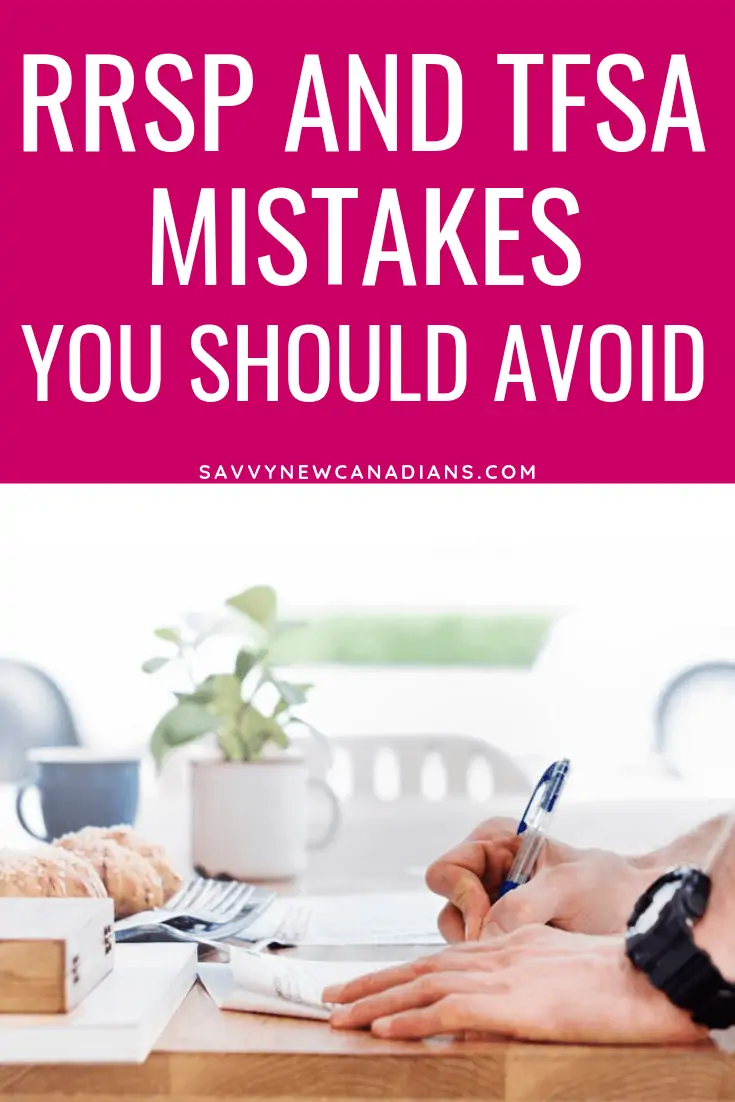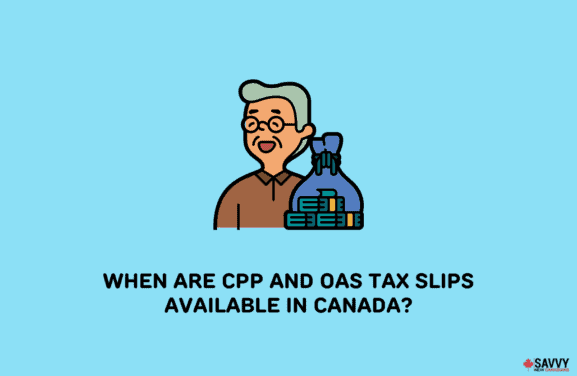The RRSP is generally well-known as the best investment account to save for retirement in Canada. The TFSA is a close second.
In addition to planning for retirement, the RRSP has other uses – such as saving for a home down payment and funding your education. As for the TFSA, it is very flexible and can be used to meet multiple financial goals.
Despite the popularity of these two registered accounts among Canadians, there are some common mistakes you should avoid, which can be costly to your pocket and financial/retirement plans.
Read on to learn about the top RRSP and TFSA mistakes you should watch out for.
Tax-Free Savings Account (TFSA) Mistakes
The TFSA account allows you to save and invest tax-free. Income earned on your account remains tax-free even when you make a withdrawal.
A TFSA account can be used to save for retirement, as an emergency fund, or to meet any other financial goal.
The TFSA was introduced in 2009, and if you have been eligible to contribute since its inception, your total contribution room is $95,000 (as of 2024, assuming no contributions or withdrawals to date).
Here are some of the common TFSA mistakes you should avoid.
1. Limiting Your TFSA To Savings
I have come across many people who misunderstand the ‘TFSA’ as simply a ‘savings account.’ So, they keep cash and GICs in their TFSA and withdraw whenever they need money.
You should manage your TFSA account as you would any other investment account. While it is more flexible than an RRSP, I consider it just as important as the RRSP for retirement savings.
While cash may work in your TFSA if your purpose is to use it as an emergency fund, it does not cut it for long-term retirement savings.
2. Being Too Risk Averse
Referring back to the point above, if your TFSA is 100% made up of cash and GICs (for example), your portfolio is deemed to be highly conservative.
A conservative portfolio makes sense if you are saving for a short-term goal, e.g. vacation, home down payment, wedding, car purchase, etc.
If you are saving towards a retirement that is 10 years or more in the future, you will need to take on more risk if you want to grow your account.
A TFSA can hold most investment assets, including stocks, bonds, ETFs, mutual funds, GICs, gold and silver bars, and others.
3. Over-Contributing To Your TFSA
Every year, the Canada Revenue Agency announces the TFSA contribution limit for the year. You can contribute this amount plus any unused contribution room carried forward from previous years. The TFSA contribution room for 2024 is $7,000. It was $6,500 in 2023.
Unlike the RRSP, there is no excess contribution buffer amount for TFSAs. All excess contributions attract a 1% per month penalty.
For example, if your excess contribution in January is $1,000 and you do not withdraw it until the end of the year, you will pay $120 in taxes.
Most people who overcontribute do so because they forget to track their contribution room or re-contribute a withdrawal in the same calendar year.
4. Cash Transfer of TFSA To Another Institution
If you withdraw cash from your TFSA and transfer it to another TFSA, it is considered a contribution and could result in an over-contribution with corresponding tax penalties.
The right way to move your TFSA from one bank to another is to effect a direct transfer (in cash or in kind) using Form T2033.
Talk to your bank and let them guide you through the process so you can avoid unexpected tax consequences.
5. Holding Foreign (U.S.) Dividend Stocks
Foreign dividend stocks, including U.S. dividends, are subject to a withholding tax when held inside a TFSA. For U.S. stocks, the withholding tax is 15% and is not recoverable. This tax does not apply if the same assets are held inside an RRSP account.
As such, U.S. stocks may be better off in your RRSP or non-registered investment accounts. However, note that taxes are just part of the puzzle when allocating assets to any of your investment accounts.
6. Making a Non-Resident TFSA Contribution
You should avoid making TFSA contributions while you are a non-resident of Canada.
Contributions by a non-resident (even if you have a TFSA contribution room) are subject to a 1% monthly tax, and this penalty continues until you withdraw the amount and submit relevant forms or you become a resident.
7. Actively Trading Within a TFSA (Day Trading)
If you day trade securities within your TFSA, the CRA may deem you to be carrying on business activity and tax any gains.
Effectively, this could mean that capital gains, dividends, and interest income are taxed at your marginal tax rate.
While there are no specific limits to how many trades you can place in your TFSA trading account, be careful about high-frequency trading.
Registered Retirement Savings Plan (RRSP) Mistakes
As the name implies, an RRSP is a unique investment account designed to help Canadians save/invest for retirement on a tax-deferred basis. You can make contributions (up to a maximum amount) every year and receive tax deductions based on your contribution.
No taxes are paid on your RRSP funds until you start making withdrawals in retirement. Upon withdrawal, you pay taxes – hopefully at a lower tax rate.
It is this tax-free growth combined with the miracle of compound interest that makes the RRSP such a great retirement planning vehicle. That being said, some of the RRSP mistakes you should avoid include the following:
8. Making Early Withdrawals
The RRSP is designed for long-term retirement savings and is not a piggy bank or emergency fund you should access at will. Early withdrawals attract a withholding tax of 10% to 30%, which the bank pays directly to the government.
The amount you withdraw is added to your income for the year, and depending on your marginal tax rate, you may still owe taxes when you file your annual tax return.
Additionally, perhaps the most damaging effect of early withdrawals is that you lose the RRSP contribution room permanently. The funds you withdraw cannot be re-contributed.
There are exceptions to the consequences above if you take out funds under the Home Buyers’ Plan or the Lifelong Learning Plan.
9. Over-Contributing To Your RRSP
The government publishes the maximum amount you can contribute to your RRSP annually. For example, for 2024, you can contribute up to 18% of your earned income in 2023, up to a maximum of $31,560. This is in addition to any unused contribution room you have carried forward from previous years.
The government gives you a lifetime $2,000 buffer for excess contributions. When you exceed this amount, a 1% monthly tax kicks in on your excess RRSP contributions.
To avoid making excess contributions, pay attention to the unused RRSP room shown on the most recent Notice of Assessment you received from CRA and track your contribution through the year.
10. Spending Your Tax Refund
Who doesn’t like a juicy fat tax refund in April?
A tax refund feels like ‘free money’ but it isn’t. Part or all of the tax deduction (and refund) you receive as a result of your RRSP contribution is going to be repaid in the future when you withdraw funds.
Re-invest your tax refund in your RRSP or TFSA.
Also, consider updating Form TD1 and T1213 so that lower taxes are deducted at source from your income, and you do not have to wait until April (tax season) to invest your tax refunds.

11. Ignoring Spousal RRSPs
Spousal RRSPs are a great way to split income among couples and lower the overall burden of the family.
For example, if your income is significantly higher than your partner’s, you can contribute to a spousal RRSP in their name. This involves using your own contribution room and claiming the tax deductions at your higher marginal tax rate.
In retirement, the lower-earning spouse has more funds they can withdraw at a lower tax rate (and for you, it is less money you need to withdraw at a higher tax rate).
Spousal RRSPs help to balance income between spouses and can leave the family with lower taxes owing.
A spousal RRSP also comes into play if you are 71 and your spouse is younger.
At age 71, you can no longer operate an RRSP account. However, if you have a contribution room, you can continue contributing to the spousal RRSP account of your spouse, who is not yet 71.
12. Not Maximizing Employer RRSP Matching Contributions
Everyone wants free money, right? Yes, and that is what employer RRSP matching contributions are!
However, not all employees take advantage of Group RRSPs, where employers offer to match employee contributions up to a certain percentage.
At an average of 3-5% of your salary, you should maximize any offer to match your contributions so you can grow your retirement pot quickly.

TFSAs and RRSPs Mistakes
There are mistakes people make which are common to both TFSAs and RRSPs.
Poor Investment Management
Several factors can contribute to overall poor portfolio management, including:
13. Inadequate Diversification
Ensure your TFSA/RRSP investment portfolio is adequately diversified so it can better weather the ups and downs of the markets. A diversified portfolio is easily obtained using mutual funds or index funds/ETFs.
If you are a self-directed investor using a multiple-fund portfolio, remember to re-balance at least 1-2 times a year. If investing using individual stocks, be careful not to put all your eggs in one basket.
14. Paying High Fees
Investment fees matter!
Active equity mutual funds are generally expensive in Canada at an average of 1.98% per year. The evidence shows that most active mutual fund managers underperform their benchmark index, which means that the high fee you are paying is mostly for naught.
Take a look at the fees you are paying and any potential savings.
Index funds and Exchange Traded Funds (ETFs) are significantly cheaper. There are also one-fund ETF solutions that do not require any re-balancing.
Alternatively, you can check out robo-advisors in Canada for low-fee and hassle-free investing options.
15. Non-Qualified or Prohibited Investments
Not all assets are eligible to be held in an RRSP or TFSA. Eligible assets are referred to as qualified investments, and ineligible assets are referred to as non-qualified or prohibited investments.
When you do not follow the rules, a penalty tax is levied equal to 50% of the fair market value of a non-qualified/prohibited investment, and up to 100% tax is levied on any income earned.
16. Invest Now, Not Later
Do not wait until the end of the year to contribute to your RRSP or TFSA accounts.
Start contributing early in the year (even if in smaller amounts) to take full advantage of compound interest and tax-free growth all year long.
Set up preauthorized contributions through your chequing account.
17. Poor Financial Planning
You should have a financial plan for your RRSP and TFSA funds. There are different approaches to take with your account, depending on what you are saving for.
Also, it is important that you update your financial/investment plan on a regular basis. For example, your portfolio’s asset allocation may need updating to align with changes in your investment goals and risk tolerance.
Tax minimization is a part of financial planning. Interest-bearing investments are better off in an RRSP, whereas stocks (dividends and capital gains) are taxed more favourably inside a non-registered account.
If you are carrying high-interest debt (credit cards), pay it off first before investing. The cost of credit card debt exceeds any realistic returns you can expect on your TFSA or RRSP portfolio. There are some scenarios where it may make sense to take out an RRSP loan.
18. Poor Estate Planning
Don’t forget to name a beneficiary on your TFSA and RRSP accounts.
TFSA: You can designate anyone as your beneficiary. If choosing a spouse or common-law partner, designate them as a Successor Holder. A successor holder replaces you as the plan holder and keeps the account open. This saves on probate fees and taxes.
In Quebec, TFSAs must be included in the estate.
RRSP: There are multiple options for designating RRSP beneficiaries. For more information, read my article on what happens to an RRSP and TFSA after death.
Don’t forget to update your beneficiary information if your circumstances or wishes change.
TFSA vs. RRSP
While it is preferable to max out your contributions to both accounts, it is not always possible.
If you have to choose between investing in an RRSP or TFSA, check out the factors you should consider in the link.
Related Reading
- How To Generate Income From an RRSP in Retirement
- Everything You Need To Know About RRIFs
- Wealthsimple Review: Investing Made Easy
- A Complete Guide To Retirement Income in Canada
- Provincial Benefits For Seniors in Retirement
- Understanding The Pension Income Tax Credit
- How Much Money Will You Need in Retirement?
FAQs
No. You typically do not pay taxes on the capital gains realized in your TFSA account. Dividends earned are also tax-free.
The dividends paid by the stocks or equities held in your TFSA investment account do not count towards your TFSA contribution.
No. You can withdraw funds from your TFSA anytime without paying tax on the withdrawals. Note that the TFSA funds you withdraw can only be re-contributed in the following year or future years.
TFSA contributions are not tax-deductible, i.e. you can’t lower your taxable income for the year using the amounts you contributed to your TFSA.




Hello! Thank you for the article. I have a few questions 🙂
What is an example of “Interest-bearing investments”?
Are foreign U.S. dividend ETFs in a TFSA also subject to a withholding tax?
Why do some assets, such as VIG, Vanguard Dividend Appreciation Index Fund ETF, have both Index Fund and ETF in their name? Aren’t Index funds and ETFs different?
@Abiola: A good example of an interest bearing investment is a GIC. Bonds, Treasuries, savings, etc. are others.
Any US listed investment that pays dividends in a TFSA would be subject to the withholding tax.
ETFs and index funds are often used interchangeably. In the case of VIG, it means this ETF is trying to replicate the performance of a specific fund (i.e. S&P U.S. Dividend Growers Index).
One way to look at this is that both “ETFs” and “index funds” are often passively managed i.e. hold constituent stocks to mirror a specific index so it can produce similar returns as that index. Unlike “actively managed” funds, the fees are lower.